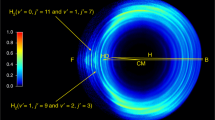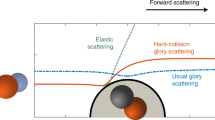Abstract
Accurate measurements of product state-resolved angular distributions are central to fundamental studies of chemical reaction dynamics. Yet, fine quantum-mechanical structures in product angular distributions of a reactive scattering process, such as the fast oscillations in the forward-scattering direction, have never been observed experimentally and the nature of these oscillations has not been fully explored. Here we report the crossed-molecular-beam experimental observation of these fast forward-scattering oscillations in the product angular distribution of the benchmark chemical reaction, H + HD → H2 + D. Clear oscillatory structures are observed for the H2(v′ = 0, j′ = 1, 3) product states at a collision energy of 1.35 eV, in excellent agreement with the quantum-mechanical dynamics calculations. Our analysis reveals that the oscillatory forward-scattering components are mainly contributed by the total angular momentum J around 28. The partial waves and impact parameters responsible for the forward scatterings are also determined from these observed oscillations, providing crucial dynamics information on the transient reaction process.
This is a preview of subscription content, access via your institution
Access options
Access Nature and 54 other Nature Portfolio journals
Get Nature+, our best-value online-access subscription
$29.99 / 30 days
cancel any time
Subscribe to this journal
Receive 12 print issues and online access
$259.00 per year
only $21.58 per issue
Buy this article
- Purchase on Springer Link
- Instant access to full article PDF
Prices may be subject to local taxes which are calculated during checkout






Similar content being viewed by others
References
Airy, G. B. On the intensity of light in the neighborhood of a caustic. Trans. Camb. Philos. Soc. 6, 379–403 (1838).
Nussenzveig, H. M. The theory of the rainbow. Atmospheric Phenomena 60–71 (Freeman, San Francisco, CA, 1980).
Neumark, D. M., Wodtke, A. M., Robinson, G. N., Hayden, C. C. & Lee, Y. T. Experimental investigation of resonances in reactive scattering: the F+H2 reaction. Phys. Rev. Lett. 53, 226–229 (1984).
Dai, D. X. et al. Interference of quantized transition-state pathways in the H+D2→D+HD chemical reaction. Science 300, 1730–1734 (2003).
Berteloite, C. et al. Kinetics and dynamics of the S(1D2) + H2 → SH + H reaction at very low temperatures and collision energies. Phys. Rev. Lett. 105, 203201 (2010).
Dong, W. et al. Transition-state spectroscopy of partial wave resonances in the F + HD reaction. Science 357, 1501–1502 (2010).
Jambrina, P. G. et al. Quantum interference between H + D2 quasiclassical reaction mechanisms. Nat. Chem. 7, 661–647 (2015).
Harich, S. A. et al. Forward scattering due to slowdown of the intermediate in the H + HD → D + H2 reaction. Nature 419, 281–284 (2002).
Aoiz, F. J., Herrero, V. J. & Rábanos, V. S. Quasiclassical state-to-state reaction cross sections for D + H2(v = 0, j = 0) → HD(v′,j′) + H: formation and characteristics of short-lived collision complexes. J. Chem. Phys. 97, 7423–7436 (1992).
Miller, W. H. & Zhang, J. Z. H. How to observe the elusive resonances in H or D + H2 → H2 or HD + H reactive scattering. J. Phys. Chem. A 91, 12–19 (1991).
Greaves, S. J., Murdock, D. & Wrede, E. A quasiclassical trajectory study of the time-delayed forward scattering in the hydrogen exchange reaction. J. Chem. Phys. 128, 164307 (2008).
Aoiz, F. J., Bañares, L. & Castillo, J. F. D. Sokolovski energy dependence of forward scattering in the differential cross section of the H + D2 → HD(v′ = 3, j′ = 0) + D reaction. J. Chem. Phys. 117, 2546–2556 (2002).
Goldberg, N. T., Zhang, J. Y., Miller, D. J. & Zare, R. N. Corroboration of theory for H + D2 → HD(v′ = 3, j′ = 0) + D reactive scattering dynamics. J. Phys. Chem. A 112, 9266–9268 (2008).
Monks, P. D. D., Connor, J. N. L. & Althorpe, S. C. Nearside-farside and local angular momentum analyses of time-independent scattering amplitudes for the H + D2 (v i = 0, j i = 0) → HD(v f = 3, j f = 0) reaction. J. Phys. Chem. A 111, 10302–103112 (2007).
Monks, P. D. D., Connor, J. N. L. & Althorpe, S. C. Theory of time-dependent reactive scattering: cumulative time-evolving differential cross sections and nearside-farside analyses of time-dependent scattering amplitudes for the H + D2 → HD + D reaction. J. Phys. Chem. A 110, 741–748 (2006).
Wang, X. A. et al. HF(v′ = 3) forward scattering in the F + H2 reaction: shape resonance and slow-down mechanism. Proc. Natl Acad. Sci. USA 105, 6227–6231 (2008).
Castillo, J. F., Manolopoulos, D. E., Stark, K. & Werner, H. J. Quantum mechanical angular distributions for the F + H2 reaction. J. Chem. Phys. 104, 6531–6546 (1996).
Sokolovski, D., De Fazio, D., Cavalli, S. & Aquilanti, V. On the origin of the forward peak and backward oscillations in the F + H2(v = 0) → HF(v′ = 2) + H reaction. Phys. Chem. Chem. Phys. 9, 5664–5671 (2007).
Connor, J. N. L. Theory of forward glory scattering for chemical reactions. Phys. Chem. Chem. Phys. 6, 377–390 (2004).
Xiahou, C. & Connor, J. N. L. Theory of forward glory scattering for chemical reactions: accuracy of semiclassical approximations using a J-shifted Eckart parameterization for the scattering matrix element. Mol. Phys. 104, 159–175 (2006).
Fleming, D. G. et al. Kinetic isotope effects for the reactions of muonic helium and muonium with H2. Science 331, 448–450 (2011).
Jankunas, J. et al. Seemingly anomalous angular distributions in H + D2 reactive scattering. Science 336, 1687–1690 (2012).
Kitsopoulos, T. N., Baldwin, D. P., Zare, R. N. & Chandler, D. W. Reaction product imaging: the H + D2 reaction. Science 260, 1605–1610 (1993).
Neuhauser, D. et al. State-to-state rates for the D + H2(v = 1, j = 1) → HD(v’,j’) + H reaction: predictions and measurements. Science 257, 519–522 (1992).
Zare, R. N. The hydrogen games and other adventures in chemistry. Annu. Rev. Phys. Chem. 64, 1–19 (2013).
Aoiz, F. J., Banares, L. & Herrero, V. J. The H + H2 reactive system. Progress in the study of the dynamics of the simplest reaction. Int. Rev. Phys. Chem. 24, 119–190 (2005).
Althorpe, S. C. et al. Observation and interpretation of a time-delayed mechanism in the hydrogen exchange reaction. Nature 416, 67–70 (2002).
Fernández-Alonso, F. & Zare, R. N. Scattering resonances in the simplest chemical reaction. Annu. Rev. Phys. Chem. 53, 67–99 (2002).
Truhlar, D. G. & Wyatt, R. E. History of H3 kinetics. Annu. Rev. Phys. Chem. 27, 1–43 (1976).
Schnieder, L. et al. Experimental studies and theoretical predictions for the H + D2 → HD + D reaction. Science 269, 207–210 (1995).
Goldberga, N. T. et al. Vibrationally inelastic H + D2 collisions are forward-scattered. Proc. Natl Acad. Sci. USA 105, 18194–18199 (2008).
Jankunas, J. et al. Is the simplest chemical reaction really so simple? Proc. Natl Acad. Sci. USA 111, 15–20 (2014).
Fernández-Alonso, F. et al. Evidence for scattering resonances in the H + D2 reaction. Angew. Chem. Int. Ed. 39, 2748–2752 (2000).
Vogels, S. N. et al. High-resolution imaging of velocity-controlled molecular collisions using counter propagating beams. Phys. Rev. Lett. 113, 263202 (2014).
von Zastrow, A. et al. State-resolved diffraction oscillations imaged for inelastic collisions of NO radicals with He, Ne and Ar. Nat. Chem. 6, 216–221 (2014).
Vogels, S. N. et al. Imaging resonances in low-energy NO–He inelastic collisions. Science 350, 787–790 (2015).
Onvlee, J. et al. Imaging quantum stereodynamics through Fraunhofer scattering of NO radicals with rare-gas atoms. Nat. Chem. 9, 226–233 (2017).
Sun, Z., Guo, H. & Zhang, D. H. Extraction of state-to-state reactive scattering attributes from wave packet in reactant Jacobi coordinates. J. Chem. Phys. 132, 084112 (2010).
Boothroyd, A. I., Keogh, W. J., Martin, P. G. & Peterson, M. R. A refined H3 potential energy surface. J. Chem. Phys. 104, 7139–7152 (1996).
Bouakline, F., Althorpe, S. C. & Peláez Ruiz, D. Strong geometric-phase effects in the hydrogen-exchange reaction at high collision energies. J. Chem. Phys. 128, 124322 (2008).
Juanes-Marcos, J. C., Althorpe, S. C. & Wrede, E. Theoretical study of geometric phase effects in the hydrogen-exchange reaction. Science 309, 1227–1230 (2005).
Jankunas, J., Sneha, M., Zare, R. N., Bouakline, F. & Althorpe, S. C. Disagreement between theory and experiment grows with increasing rotational excitation of HD(v′, j′) product for the H + D2 reaction. J. Chem. Phys. 138, 094310 (2013).
Kendrick, B. K. Geometric phase effects in chemical reaction dynamics and molecular spectra. J. Phys. Chem. A 107, 6739 (2003).
Chao, S. D. et al. A fully state- and angle-resolved study of the H + HD → D + H2 reaction: comparison of a molecular beam experiment to ab initio quantum reaction dynamics. J. Chem. Phys. 117, 8341–8361 (2002).
Greaves, S. J., Murdock, D., Wrede, E. & Althorpe, S. C. Fully quantum state-resolved inelastic scattering of NO(X)+Kr: differential cross sections and product rotational alignment. J. Chem. Phys. 128, 164306 (2008).
Zhang, J. Z. H. & Miller, W. H. Quantum reactive scattering via the S-matrix version of the Kohn variational principle: Differential and integral cross sections for D + H2 → HD + H. J. Chem. Phys. 91, 1528 (1989).
Jankunas, J., Sneha, M., Zare, R. N., Bouakline, F. & Althorpe, S. C. Hunt for geometric phase effects in H + HD → HD(v′,j′) + H. J. Chem. Phys. 139, 144316 (2013).
Acknowledgements
This work was supported by the National Natural Science Foundation of China (NSFC Center for Chemical Dynamics), the Strategic Priority Research Program of Chinese Academy of Sciences (grant no. XDB17000000) and the Ministry of Science and Technology. The authors also thank Ting Xie, Siwen Wang, Yuxin Tan and Qiming Qiu for their help with the experiment.
Author information
Authors and Affiliations
Contributions
X.Y., D.H.Z., Z.S. and X.W. conceived and supervised the research. The experiments were carried out by D.Y., S.Y., W.C., J.S., C.L., P.C. and X.W. Data analysis and interpretation were performed by D.Y., S.Y., W.C., T. W.,P.C., X.W. and X.Y. Theoretical calculations were performed by X.X., Z.S. and D.H.Z. The manuscript was written by X.Y., D.H.Z., Z.S. and X.W., with contributions from all authors. All authors contributed to discussions about the content of the paper.
Corresponding authors
Ethics declarations
Competing interests
The authors declare no competing interests.
Additional information
Publisher’s note: Springer Nature remains neutral with regard to jurisdictional claims in published maps and institutional affiliations.
Supplementary information
Supplementary Information
Supplementary Methods, Results, Fig. 1–9 and Table 1
Rights and permissions
About this article
Cite this article
Yuan, D., Yu, S., Chen, W. et al. Direct observation of forward-scattering oscillations in the H+HD→H2+D reaction. Nature Chem 10, 653–658 (2018). https://doi.org/10.1038/s41557-018-0032-9
Received:
Accepted:
Published:
Issue Date:
DOI: https://doi.org/10.1038/s41557-018-0032-9
This article is cited by
-
Observation of geometric phase effect through backward angular oscillations in the H + HD → H2 + D reaction
Nature Communications (2024)
-
Crossed molecular beam studies of bimolecular reactions of atomic oxygen with nitrogen-bearing organic molecules (nitriles and N-heterocyclic)
Rendiconti Lincei. Scienze Fisiche e Naturali (2024)
-
Observation of the geometric phase effect in the H+HD→H2+D reaction below the conical intersection
Nature Communications (2020)



